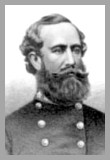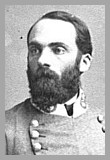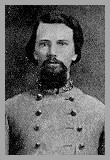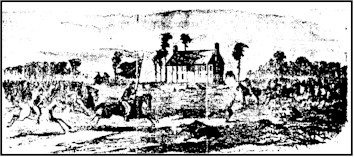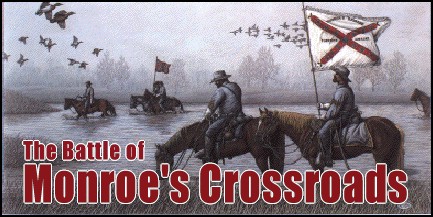
@2009 - Sue Ashby Updated 09/02/2009
![]()
Kilpatrick's Shirt-Tail Skedaddle
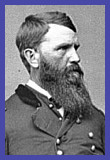 Francis P. Blair, Jr. |
. . . Before General Blair ordered the Seventeenth Corps to move from Campbell's Bridge on March 9, he sent a mounted infantry regiment to Lumberton,(1) some thirty miles east, with orders to burn all bridges and railroad property in the area. Since late February the people of Lumberton had been in a dilemma as to Sherman's destination. The Methodist minister in town, Washington S. Chaffin, said that each day brought a different rumor as to Sherman's whereabouts. It so happened that Chaffin had just entered in his diary on March 9: "The Yankees are said to be in two different places near here. I am incredulous . . ." when shouts of "The Yankees are coming, the Yankees are coming' were heard in the distance. Dropping his pen, the minister rushed to the window where he saw the streets instantaneously fill up with troops. In the front of his very door, Chaffin saw a neighbor of his fired upon twice when he tried to run. |
| Before the pastor fully realized what was
happening,
a cavalryman had robbed him of Mrs. Chaffin's watch and stolen his
horse,
Kate In this raid the Federals destroyed the wagon and railroad bridges
over the Lumber River, the rail depot, six box cars, and about a mile
of
track. Following their usual custom, the soldiers entered many house
and
committed many depredations. After the troops departed, the clergymen
completed
the entry in his diary which had been so rudely interrupted. His chief
concern seemed not to be for his wife, "who was greatly excited," but
for
Kate whom he had owned for "five years, 11 months, 17 days - she had
never
been sick - I traveled with her on horseback, etc., 17,102 miles."
Nightfall of this same day found the Seventeenth, Fourteenth, and Twentieth Corps encamped at Raft Swamp between the fifteen and twenty-mile posts on the Fayetteville plank road and near McFarland's Bridge over the Lumber River.(2) The day's march, because of heavy rains, had been extremely difficult for all. Practically every foot of the way had to be corduroyed with fence rails and split saplings. |
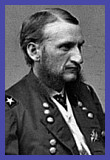 Hugh Judson Kilpatrick |
The Federal cavalry under General Kirkpatrick
had crossed
the Lumber River on the night of March 8 and at Solemn Grove (Monroe's
Cross-Roads), a crossroads around ten miles north of Love's Bridge, had
struck the rear of Lieutenant General W. J. Hardee's column, capturing
a number of prisoners. From these prisoners Kilpatrick learned that
General
Hampton's cavalry was a few miles in the rear and marching rapidly for
Fayetteville. An examination of his map showed Kilpatrick that Hampton
could be moving on any one or more of three different roads. Hoping to
intercept the Confederate cavalry, Kilpatrick assigned each of his
brigades
the corner of a triangle that not only crossed the possible enemy lines
of march but also made it feasible for the brigades to protect one
another.
The excitement and graveness of an expected clash with Hampton caused the Federal commander to spend much of the afternoon passing from one of his detachments to another. For consolation in such troubled times, "little Kil" shared the carriage of a beautiful young lady accompanying the army north. Made to walk behind the carriage was a Confederate prisoner, Lieutenant H. Clay Reynolds, who was able to view from a close range the entertaining spectacle of the General lying with his head in his lady friend's lap. That night Kilpatrick made his camp with Colonel George E. Spencer's brigade north of Solemn Grove. |
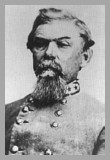 William J. Hardee
|
| About dusk the Confederate cavalry, lead by
Major General
M. C. Butler's division of Hampton's command, approached the vicinity
of
Solemn Grove. Captain M. B. Humphrey's squadron, Sixth South Carolina
cavalry,
was the advanced guard of the column, and Wheeler's division brought up
the rear. At the intersection of one of the Fayetteville roads,
Humphrey
noticed that a heavily mounted column had just passed. He reported the
fact to Butler, and while they were discussing the situation, a squad
of
thirty Federal cavalrymen of the Fifth Kentucky appeared on the road.
By
a bit of trickery, Butler was able to capture all of them without
firing
a shot, with the exception of General Kilpatrick, who was with the
detachment
at the moment but managed to escape with his staff.
Hampton, upon learning that Kilpatrick was near, decided to attack the Federal camp at daylight the next morning, March 10. During the early part of the evening, one of Kilpatrick's officers mistakenly rode into the Confederate lines and was brought immediately to General Butler for questioning. Butler was able to learn from this officer the location of Kilpatrick's headquarters, which were in the Charles Monroe dwelling. Around midnight Butler reconnoitered the Federal position and learned that Kilpatrick had posted no pickets to protect his rear. This enabled Butler and his men to ride almost up to the camp fires without being noticed. Kilpatrick had moved around the head of a swamp and pitched his camp in front of it. His rear and right were protected by the swamp, but his left was entirely exposed. |
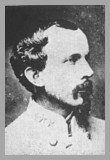 Matthew C. Butler
|
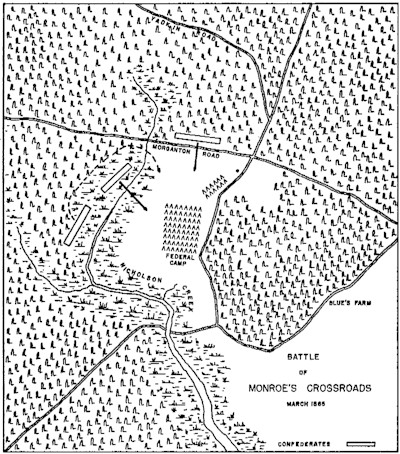
| With this information Generals Hampton,
Wheeler and
Butler formed their plan of battle. The attack, which was to commence
at
daylight, was to be led by Butler. He was to move when the head of
Wheeler's
column appeared in the rear. He was to follow the road taken by
Kilpatrick,
move around the head of the swamp, and fall suddenly on the
Federal
camp from the west. Wheeler had instructions to move through the woods
to the right and attack from the rear. Captain Bostick of Young's
brigade
was given the task of capturing General Kilpatrick. He was instructed
upon
entering the Federal camp at daylight to rush straight for the house in
which Kilpatrick had his headquarters. He was to surround the building
and hold his position until assistance came.
By nine o'clock on the evening of March 9, Brigadier Generals Thomas J. Jordan and Smith D. Atkins, commanding Kilpatrick's First and Second Brigades respectively, discovered that while Hampton had been amusing them in front, he was passing with his main force on a road to his right. These officers at once made every effort to reach Kilpatrick before dawn but failed to do so, owing to bad roads and almost incessant skirmishing with the Confederates, who were marching on a parallel road at some points not a mile distant. The Confederate and Federal columns were so close that some of the time they became mixed together. One of Wheeler's men said that on this particular night he happened to glance up one time and discovered, much to his surprise, that a number of Federal cavalrymen were riding by his side and that by the time he had reported this to his captain at the head of the column, the Federals had disappeared, taking with them as prisoners the Confederate rear guard. |
| The night hours dragged by for Butler's men
who halted
in the woods near the enemy camp. The period passed in complete silence
and darkness. All conversation was prohibited. No fires were allowed.
Each
man sat on the ground holding the bridle-rein of his saddled mount and
wondering what the morning held for him. Occasionally
passing
through the mind of a trooper was the intriguing thought that he might
get a close look at Kilpatrick's fair lady. Just before the break of
dawn,
Colonel "Gid" Wright of Butler's division gave the long-awaited command
to mount up, and with the first rays of daylight, he struck
Kilpatrick's
camp, which was found to be without a picket or camp guard. Following
immediately
in his rear was General Butler with the other brigades. Riding into a
sleeping
camp, the Confederate cavalrymen were able to put the entire Federal
command,
including the General himself, to flight in less than a minute. For a
moment
it looked like a cyclone had struck the encampment. Blankets were
flying
in the air and men in their night clothes were running in every
direction.
A stampede on foot was underway. Kilpatrick called this attack "the
most
formidable cavalry charge I have ever witnessed." Although his
headquarters
were taken, the General managed to avoid capture and reached his camp a
few hundred yards to the rear, where a fight was going on between his
men
and the Confederates for possession of the camp and animals.(3)
To make his escape "little Kil" Had to spring from the warm bed of his lovely lady. The first thought to enter his mind at the sound of piercing "Rebel" yells was not the embarrassment of having such a delightful nocturnal slumber abruptly interrupted but that his four years of hard fighting for a major general's commission were going up with the surprise attack. The initial shock of this unexpected visit did not completely separate the cavalry commander from his wits, however. While standing in front of his headquarters, a Confederate rider dashed up to Kilpatrick and asked him if he had seen the General, to which he replied, "There he goes on that black horse," pointing to a man making off on such a mount. Thereupon the soldier pursued the figure pointed out to him. Kilpatrick, clad only in his night clothes, then jumped upon the nearest horse and made a hasty departure.(4) By this time, chance bullets were fast perforating the weatherboards of the headquarters house. This was sufficient to bring the General's forsaken damsel to the doorway.(5) For a moment she looked disconsolately at her carriage as if the vague idea were dawning that it was time for her to be leaving. This was followed by a short period of mute despair when it became apparent to her that the carriage would not move without horses. The strange apparition of a lovely young woman in scanty night dress on the field of battle brought one Confederate captain's horse to a fast halt. Southern Chivalry rose to the occasion. Dismounting, the cavalryman led the distressed one to the safety of a nearby ditch. |
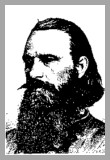 Ambrose R. Wright
|
| Shortly thereafter Kilpatrick and his
cavalrymen were
driven back some five hundred yards to the swamp. The Confederates,
however,
did not follow up this initial success. General Kilpatrick said they
stopped
to plunder and this gave him time to rally his men. General Butler
explained
this loss of initiative by the fact that Wheeler was unable to cross
the
swamp and attack from the rear and that Brigadier General E. M. Law's
brigade,
which he ordered to move up and take possession of the camp after
Wright's
Command had been scattered, had been, without his knowledge, ordered to
some other point by General Hampton. No matter what the cause, the fact
remains that the Confederate cavalry did not follow up their surprise
attack.
This enabled to Federals to rally and with the aid of rapid-fire
Spencer
carbines, to retake their camp and artillery.(6)
About eight o'clock, Brigadier General J. G. Mitchell's brigade of the Fourteenth Corps came to Kilpatrick's assistance. Although the fighting was over, this infantry brigade moved into position and remained with Kilpatrick until 1:30 pm.
The casualty reports of this skirmish are both confusing and contradictory. Kilpatrick reported that he lost 4 officers killed and 7 wounded, 15 men killed and 61 severely and several slightly wounded, and 103 officers and men taken prisoners. He further stated that over 80 Confederate dead and a great number of wounded were left in his camp and that 30 prisoners and 150 horses were captured. The horses had been abandoned in the swamp. Wheeler said he took over 350 prisoners. General Johnson put the figure at 500 plus 173 Confederate prisoners that were freed. Kilpatrick's escape on the morning of the surprise attack is as controversial a subject as the number casualties suffered on each side. The Union General told M. C. Butler after the war that on this particular morning he had walked out of his headquarters in his slippers about daylight, as was his usual custom, to see that his horses were fed. Such a habit was certainly the exception rather than the rule for most high-ranking officers. A Confederate soldier who participated in this surprise attack presumed Kilpatrick to be the only example from Joshua to the nineteenth century of a major general who would walk out of a warm room in cold weather only partially dressed to see horses fed one hundred yards away. Captain T. F. Northrup, Kilpatrick's chief scout, said he saw General Kilpatrick before he had a chance to change his clothes and that the General had on shirt, vest, trousers, and slippers or shoes, but he was without hat, coat and probably boots. He states emphatically that no nightshirt was in evidence. However, J. W. DuBose, in his article "The Fayetteville (N.C.) Road Fight," quotes Sergeant A. F. Hardee, one of Wheeler's scouts, as follows: "General Kilpatrick left his hat, coat pants, and pistols, etc." The General did lose around thirty valuable horses from his headquarters. Among them were his two fine stallions, one a small spotted horse and the other a large black. There will always be disagreement as to who actually got the better of the fighting at Solemn (Monroe's Cross-Roads), contemptuously tagged by the Federal infantry as "Kilpatrick's Shirt-Tail Skedaddle." Yet, the fact stands that by engaging Kilpatrick in battle, Hampton was able to open the road to Fayetteville, which the Federal camp had blocked. The Confederate cavalry joined Hardee near Fayetteville that night. But there was little rest in store for the weary horsemen. |
General Lee, reporting on the Battle of Monroe's Cross-Roads to
John C. Breckingridge, Secretary of War, stated:
Headquaters March 10, 1865 (Received 7:30pm)
General Hampton Attacked General Kilpatrick at daylight this
morning
and drove him
from his camp, taking his guns, wagons, many horses, several hundred
prisoners, and
releasing a great number of our own men who had been captured. The
guns and wagons
could not be brought off for lack of horses. Many of the enemy were
killed and wounded.
Our loss not heavy. Lieut. Col. J. S. King, killed;
Brigadier-General
Humes,
Colonals Hagan and Harrison and Majors Lewis, Ferguson, and others
wounded.
R. E. Lee
Taken from "The Civil War in North Carolina"
